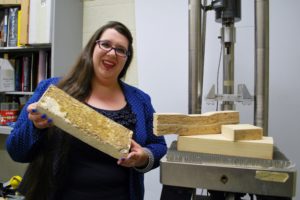BESTie doctoral student Sonia Travaglini was featured in a Berkeley Science Review article on her research.
Select quotes:
From mushroom bricks to clothing, fungi offer a huge range of unusual and novel applications. Entrepreneurs have identified fungal species that can grow into hard and tough blocks, forming bricks that can be used for constructing houses. Recently, a method has been developed to manufacture a replacement for animal-based leather using the flesh of a fungal species.
As a doctoral researcher in the UC Berkeley Department of Mechanical Engineering studying with Professor Hari Dharan and Professor Alice Agogino, I became interested in fungi by looking to nature for ideas of how to engineer alternatives to synthetic materials. I’ve become captivated by them, trying to understand how simple mushrooms can be used to create such strong materials. The promise of using fungi to produce useful resources inspired me to learn more about the biology, properties, and applications of fungi, both at UC Berkeley and with startups around the Bay Area. As an engineer it’s exciting to explore novel materials that have never been tested, and this drew me into an entirely new field of research and a whole world of fungi.
Fungi remain one of the most essential parts of our ecosystem, despite being mostly hidden from view underground. Now fungi are finally getting attention from the biotech world as possible solutions to our waste problems and our ever-increasing need for materials. We have found a way to make something useful from waste without being costly, harmful, or excessively complex. Industrialized farming of plants and animals is hardly a new idea, but the world of fungi is getting attention as a readily usable source of material and a cheap and natural solution to processing our waste. So what’s next in our uses for fungi? They already form the fabric of our ecosystems, feed us, slake our thirst with beery beverages, and now they are being developed in materials to build our homes.
Fungi have become popular not just for their taste, but for what they can become. Soon, each of us may be unwrapping our latest gadgets, composting the packaging, and then enjoying a tasty lunch of mushrooms inside our mushroom brick houses. The future may well be mushroom-shaped. And that is a good thing.
Sonia’s research was also covered by PBS KQED about her collaboration with architect Phil Ross:
A House Made From Mushrooms? An Artist Dreams of a Fungal Future. Excerpt:
“My research so far has been some of the first characterization of these materials,” said Travaglini. Currently she is experimenting with composites that meld the mycelium with more conventional materials. One creation combines the lightweight durability of mycelium with the tensile strength of bamboo.
And by manipulating growing conditions, the same mushroom mycelium can form everything from lightweight foams to durable bricks as tough as concrete. “Because it’s a natural material, what we feed it and how we grow it chooses how the properties come about,” said Travaglini.
Sonia was also cited in this Scientific American article: Making Furniture from Fungi: Your next chair or table could be all natural, free of toxins—and compostable.
Featured image: Sonia Travaglini, credit Dan Lurie

